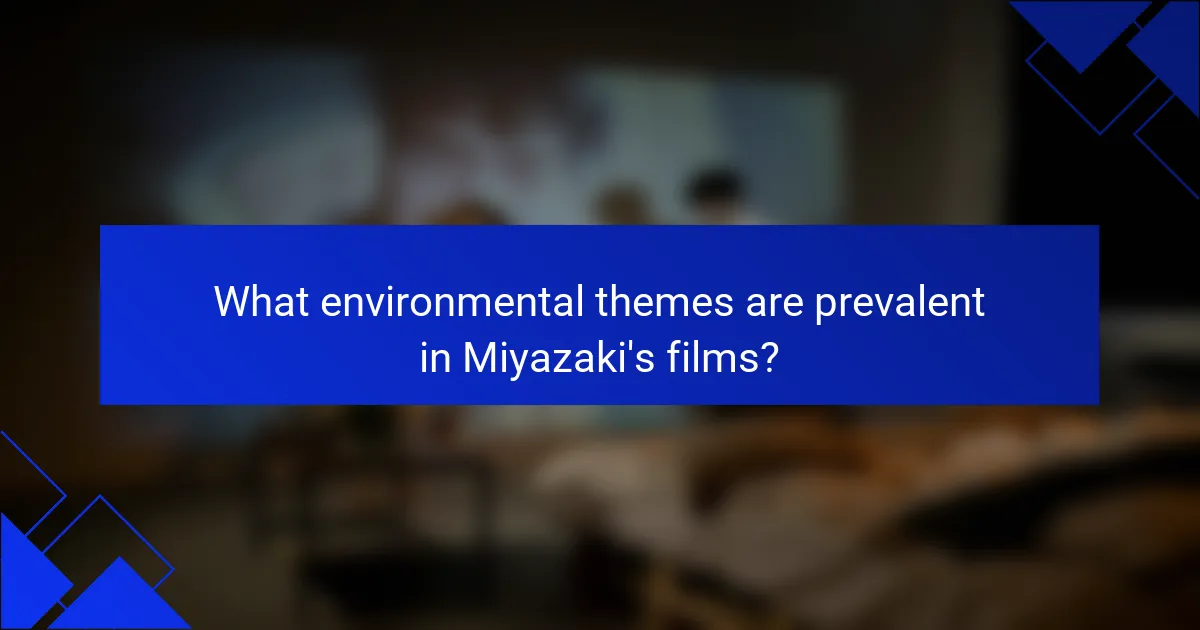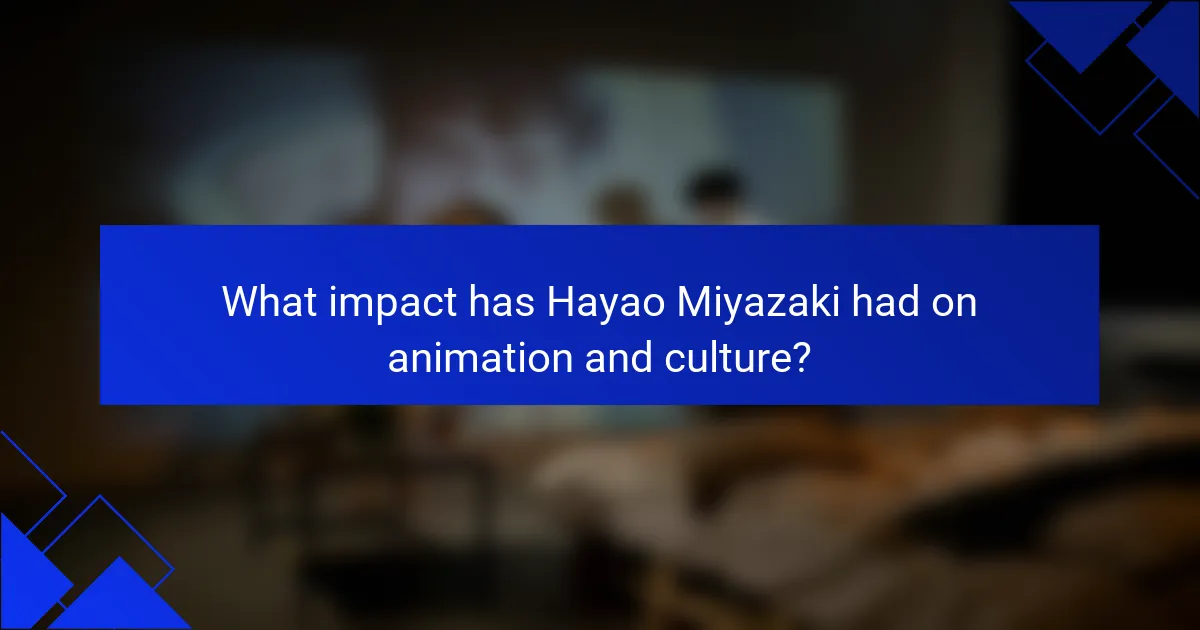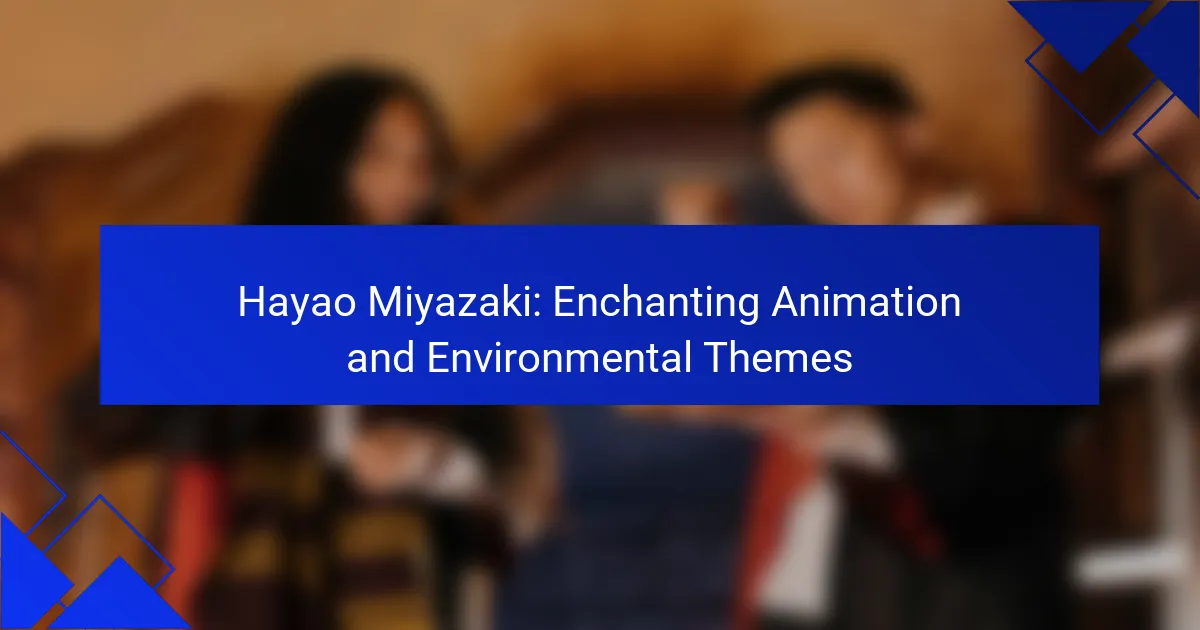
What defines Hayao Miyazaki’s animation style?
Hayao Miyazaki’s animation style is defined by its detailed artistry and emotional storytelling. His films often feature lush, hand-drawn backgrounds that create immersive worlds. Character designs are unique, showcasing expressive features that convey deep emotions. Themes of nature, environmentalism, and feminism are prevalent in his narratives. Miyazaki’s works frequently include strong female protagonists, emphasizing empowerment and resilience. The animation is fluid, with a focus on movement that enhances the storytelling. His films often blend fantasy with reality, creating a sense of wonder. Additionally, the soundtracks, composed by Joe Hisaishi, complement the visual storytelling beautifully.
How do visual elements contribute to his storytelling?
Visual elements significantly enhance Hayao Miyazaki’s storytelling. His use of vibrant colors creates emotional resonance. Detailed backgrounds immerse viewers in fantastical worlds. Character designs convey personality and emotions effectively. Symbolism in visuals reinforces themes, such as nature and environmentalism. For example, the depiction of lush landscapes highlights the importance of nature. Animation fluidity enhances the narrative flow. These elements work together to create a rich, engaging experience for the audience.
What specific techniques does Miyazaki use in his animations?
Hayao Miyazaki employs various specific techniques in his animations. He utilizes hand-drawn animation to create a unique aesthetic. This method allows for intricate details and fluid motion. Miyazaki also incorporates watercolor backgrounds, enhancing the visual depth of his films. Another technique is the use of strong character development, making protagonists relatable and engaging. He often blends fantasy with realism, grounding magical elements in relatable settings. Additionally, Miyazaki emphasizes environmental themes, showcasing nature’s beauty and fragility. His storytelling often includes minimal dialogue, allowing visuals to convey emotion. These techniques collectively contribute to the immersive experience of his films.
How do color palettes influence the mood of his films?
Color palettes significantly influence the mood of Hayao Miyazaki’s films. He employs vibrant colors to evoke emotions and enhance storytelling. For instance, warm colors like reds and yellows create a sense of joy and warmth. In contrast, cooler colors such as blues and greens often convey melancholy or tranquility. Miyazaki’s use of color also reflects the themes of nature and environmentalism present in his work. Films like “My Neighbor Totoro” feature lush greens that symbolize growth and harmony with nature. Conversely, darker palettes in films like “Spirited Away” can create tension and uncertainty. Overall, the strategic use of color enhances audience engagement and emotional response throughout his storytelling.
Why is character development significant in Miyazaki’s works?
Character development is significant in Miyazaki’s works because it drives emotional engagement and thematic depth. His characters often undergo transformative journeys that reflect personal growth. For instance, in “Spirited Away,” Chihiro evolves from a timid girl to a courageous individual. This transformation resonates with audiences, making the story relatable and impactful. The depth of characters enhances the narrative’s exploration of complex themes like identity and environmentalism. Miyazaki’s attention to character intricacies allows viewers to connect on a personal level. This connection reinforces the moral and philosophical messages embedded in his films. Ultimately, character development is essential for conveying the richness of Miyazaki’s storytelling.
What traits make his characters relatable and memorable?
Miyazaki’s characters are relatable and memorable due to their depth, vulnerability, and growth. Each character often faces personal challenges that reflect real human emotions. For instance, characters like Chihiro in “Spirited Away” undergo significant transformation through adversity. This journey resonates with audiences, making them feel connected. Additionally, Miyazaki incorporates universal themes such as friendship, courage, and environmentalism. These themes enhance the relatability of his characters. His attention to detail in character design and backstory adds layers to their personalities. This complexity makes them unforgettable in the realm of animation.
How do character arcs reflect broader themes in his films?
Character arcs in Hayao Miyazaki’s films often embody broader themes such as environmentalism and personal growth. For instance, in “Princess Mononoke,” Ashitaka’s journey reflects the struggle between industrialization and nature. His transformation showcases the need for balance between human progress and environmental preservation. Similarly, Chihiro’s arc in “Spirited Away” illustrates the importance of identity and resilience in a consumer-driven society. As she navigates the spirit world, her growth emphasizes themes of self-discovery and respect for nature. These character developments are integral to conveying Miyazaki’s overarching messages about harmony with the environment and the significance of personal responsibility.

What environmental themes are prevalent in Miyazaki’s films?
Miyazaki’s films frequently explore environmental themes such as the relationship between humans and nature. They depict the consequences of industrialization and environmental degradation. For instance, “Princess Mononoke” showcases the conflict between nature and human development. The film presents the struggle to coexist with the natural world. “My Neighbor Totoro” emphasizes the beauty of nature and the importance of preserving it. The film illustrates the bond between children and the environment. Additionally, “Nausicaä of the Valley of the Wind” addresses pollution and its effects on ecosystems. Miyazaki’s narratives often advocate for harmony with nature. These themes resonate with audiences and encourage environmental awareness.
How does Miyazaki portray nature in his storytelling?
Miyazaki portrays nature as a vital, living entity in his storytelling. His films often depict lush landscapes and intricate ecosystems. He emphasizes the interconnectedness of humans and nature. Characters frequently experience profound transformations through their interactions with the natural world. For instance, in “Princess Mononoke,” the struggle between industrialization and nature is central to the narrative. Nature is shown as both beautiful and fragile, deserving respect and protection. His works highlight environmental themes, urging viewers to appreciate and safeguard the earth. This portrayal reflects Miyazaki’s own beliefs about environmental conservation and harmony with nature.
What messages about environmentalism can be found in his narratives?
Hayao Miyazaki’s narratives convey strong messages about environmentalism. His works often highlight the beauty and fragility of nature. For example, in “Princess Mononoke,” he explores the conflict between industrialization and nature. The film showcases the consequences of environmental destruction. It portrays the struggle of forest spirits defending their home. Miyazaki emphasizes harmony between humans and the natural world. His characters often advocate for ecological balance and respect for all living beings. This reflects a deep concern for environmental issues and sustainability.
How do his films encourage a connection with the natural world?
Hayao Miyazaki’s films encourage a connection with the natural world through vivid depictions of nature and its inhabitants. His storytelling often highlights the beauty and complexity of ecosystems. For example, “Princess Mononoke” portrays the struggle between industrialization and nature. This film emphasizes the importance of coexistence and respect for all living beings. Additionally, “My Neighbor Totoro” showcases the wonder of rural landscapes and the joy of interacting with nature. Miyazaki’s characters often experience personal growth through their relationships with the environment. His films inspire viewers to appreciate and protect the natural world. This approach resonates with audiences, fostering a deeper environmental awareness.
Why is the portrayal of technology important in his works?
The portrayal of technology in Hayao Miyazaki’s works is important because it reflects the complex relationship between humanity and nature. Miyazaki often depicts technology as both a tool and a threat. In films like “Nausicaä of the Valley of the Wind,” technology serves to enhance human capabilities but also leads to environmental degradation. His narratives emphasize the consequences of unchecked technological advancement. For instance, the mecha in “Castle in the Sky” symbolizes human innovation but also the potential for destruction. This duality invites viewers to consider the ethical implications of technological progress. Ultimately, Miyazaki’s portrayal encourages a balance between technological development and environmental stewardship.
What conflicts arise between nature and technology in Miyazaki’s films?
Miyazaki’s films depict conflicts between nature and technology primarily through environmental degradation and the loss of harmony. Characters often face the consequences of industrialization, which harms natural ecosystems. For example, in “Princess Mononoke,” the conflict centers around the destructive impact of ironworks on the forest. Nature is personified through spirits that protect the environment. Technology is often portrayed as a force that disrupts this balance, leading to suffering for both humans and nature. In “Nausicaä of the Valley of the Wind,” the protagonist fights against the toxic effects of technology on the natural world. These narratives emphasize the need for coexistence and respect for nature. Miyazaki’s storytelling serves as a critique of unchecked technological advancement, advocating for environmental awareness.
How do these conflicts reflect contemporary environmental issues?
Conflicts in Hayao Miyazaki’s films reflect contemporary environmental issues by showcasing the struggle between nature and industrialization. These narratives highlight the consequences of environmental degradation. For instance, “Princess Mononoke” presents a battle between forest spirits and human exploitation. This mirrors real-world conflicts over deforestation and resource extraction. Similarly, “Nausicaä of the Valley of the Wind” addresses the impact of pollution on ecosystems. The film emphasizes the need for harmony between humans and nature. Miyazaki’s works serve as a critique of unsustainable practices. They resonate with current global environmental movements advocating for conservation.

What impact has Hayao Miyazaki had on animation and culture?
Hayao Miyazaki has profoundly influenced animation and culture through his storytelling and artistic style. His films, such as “Spirited Away,” have won numerous awards, including an Academy Award for Best Animated Feature. Miyazaki’s work emphasizes themes of nature, environmentalism, and the human experience. His unique visual style blends traditional hand-drawn animation with rich, imaginative worlds. This approach has inspired a generation of animators worldwide. Miyazaki co-founded Studio Ghibli, which has become a leading force in animation. His influence extends beyond Japan, impacting global perceptions of animated films. His narratives often challenge societal norms and promote empathy and understanding.
How has his work influenced other filmmakers and animators?
Hayao Miyazaki’s work has significantly influenced filmmakers and animators worldwide. His unique storytelling techniques have inspired a generation of creators. Miyazaki’s emphasis on strong female protagonists has reshaped character development in animation. Films like “Spirited Away” have set new standards for narrative depth and visual artistry. His environmental themes resonate with many contemporary filmmakers. The animation style he popularized has become a benchmark in the industry. Directors such as Pete Docter and Jennifer Lee cite Miyazaki as a major influence on their work. His ability to blend fantasy with reality has encouraged others to explore similar themes.
What specific films or styles have drawn inspiration from Miyazaki?
Films such as “The Secret World of Arrietty” and “Wolf Children” have drawn inspiration from Hayao Miyazaki. These films reflect his signature themes of nature and childhood. Additionally, the animation style of “Your Name” showcases visual storytelling reminiscent of Miyazaki’s work. The aesthetic choices in “Song of the Sea” also echo his influence, particularly in character design and environmental elements. Many filmmakers cite Miyazaki as a pivotal influence in their creative processes. His focus on strong female protagonists has inspired a range of contemporary animated films. The blend of fantasy and reality in his stories has shaped the narrative style of many modern animations.
How does his legacy continue to shape modern animation?
Hayao Miyazaki’s legacy continues to shape modern animation through his emphasis on storytelling and visual artistry. His films often feature strong female protagonists, which has influenced character development in contemporary animation. Additionally, his unique animation style blends hand-drawn techniques with rich, detailed backgrounds. This approach has inspired animators to prioritize artistry over computer-generated imagery. Miyazaki’s themes of environmentalism and humanity resonate in today’s animated narratives, encouraging deeper storytelling. His works, such as “Spirited Away,” have set high standards for emotional depth and cultural richness in animation. As a result, many modern animators cite him as a significant influence on their creative processes.
What practical insights can we gain from Miyazaki’s approach to storytelling?
Miyazaki’s approach to storytelling emphasizes the importance of character development and emotional depth. His narratives often feature strong, relatable protagonists who undergo significant personal growth. This technique fosters audience connection and empathy. Additionally, Miyazaki weaves environmental themes into his stories. This inclusion highlights the significance of nature and conservation in a relatable manner. His use of fantastical elements serves to engage viewers while conveying deeper messages. The combination of these techniques creates a rich, immersive experience. This approach can inspire storytellers to prioritize character and thematic depth in their narratives.
How can aspiring animators incorporate environmental themes into their work?
Aspiring animators can incorporate environmental themes into their work by focusing on storytelling that highlights nature’s beauty and fragility. They can create characters that embody environmental stewardship and advocate for sustainability. Using visuals that depict natural landscapes can evoke emotional connections to the environment. Animators can also explore the consequences of environmental neglect through their narratives. Research shows that animated films with ecological messages can influence audience attitudes toward environmental issues. For instance, Hayao Miyazaki’s films often emphasize the harmony between humans and nature, inspiring viewers to appreciate and protect the environment. By integrating these elements, animators can effectively convey important environmental themes in their projects.
What lessons about character development can be learned from Miyazaki’s films?
Miyazaki’s films teach that character development is often rooted in personal growth and resilience. Characters frequently face challenges that force them to adapt and evolve. For example, Chihiro in “Spirited Away” transforms from a timid girl to a courageous individual. This journey emphasizes the importance of self-discovery and bravery. Additionally, Miyazaki highlights the significance of empathy and connection. Characters like Totoro and the Forest Spirit embody nurturing qualities that influence others positively. The films also illustrate the complexity of human emotions. Characters often grapple with fear, love, and responsibility, showcasing a realistic portrayal of life. Overall, Miyazaki’s narratives emphasize that character development is a multifaceted journey shaped by experiences and relationships.
Hayao Miyazaki is a renowned animator known for his enchanting animation style and profound environmental themes. This article explores the defining characteristics of Miyazaki’s animation, including detailed artistry, emotional storytelling, and unique character development. Key topics include the impact of visual elements and color palettes on mood, the significance of character arcs, and the portrayal of nature and technology in his films. Additionally, the article examines Miyazaki’s influence on modern animation and the lessons that aspiring animators can learn from his approach to storytelling and character development.
